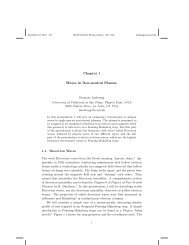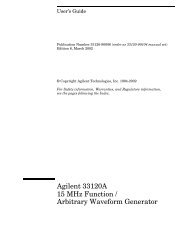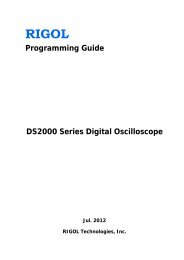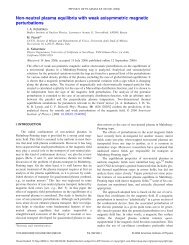ion-induced instability of diocotron modes in electron - Nonneutral ...
ion-induced instability of diocotron modes in electron - Nonneutral ...
ion-induced instability of diocotron modes in electron - Nonneutral ...
Create successful ePaper yourself
Turn your PDF publications into a flip-book with our unique Google optimized e-Paper software.
f Rd2d s<strong>in</strong>(θ d /2)H 2+L bncL end∏θ dB, zFig. 2. Cartoon <strong>of</strong> the phase shift θ d and the correspond<strong>in</strong>gdisplacement 2d s<strong>in</strong>(θ d /2) acquired by an average <strong>ion</strong>dur<strong>in</strong>g <strong>diocotron</strong> cycle <strong>in</strong> the double-well trap.Note that symmetry dictates that the end drift <strong>of</strong> the whole<strong>ion</strong> fract<strong>ion</strong> is well represented by the drift <strong>of</strong> an <strong>ion</strong>com<strong>in</strong>g from the <strong>electron</strong> column center. Upon theirreturn <strong>in</strong>to <strong>electron</strong> column, after be<strong>in</strong>g smashed by theplasma rotat<strong>ion</strong> along a circular orbit <strong>of</strong> radius2d s<strong>in</strong>(θ d /2), the <strong>ion</strong>s acquire a change <strong>in</strong> their meansquare-radius(MSR) equal to δr 2 = 2d 2 (1-cosθ d ). S<strong>in</strong>cewe have assumed that the <strong>ion</strong> mot<strong>ion</strong> becomes stochasticon the <strong>diocotron</strong> time scale t d = 1/f m , the <strong>ion</strong>s diffuse <strong>in</strong>the oscillat<strong>in</strong>g m θ -wave perturbat<strong>ion</strong> at a rate D m ª δr 2 f m ,which results <strong>in</strong>to the net change <strong>of</strong> the MSR accumulatedby the whole <strong>ion</strong> fract<strong>ion</strong> N i dur<strong>in</strong>g their active lifetime t lf<strong>in</strong> the <strong>electron</strong> column equal to( )N Δr ≡ N D τ = N f τ × 1− cos θ . (1)2i i m lf i m lf dAccord<strong>in</strong>g to the conservat<strong>ion</strong> <strong>of</strong> canonical angularmomentum 6 , the rate <strong>of</strong> change <strong>in</strong> the MSR <strong>of</strong> <strong>ion</strong>s has tobe balanced by the rate <strong>of</strong> change <strong>in</strong> the MSR <strong>of</strong> thewhole <strong>electron</strong> column, which moves further <strong>of</strong>f-axis as2N D = N 2 γ d .(2)i m e mThis gives us the <strong><strong>in</strong>stability</strong> with the m θ -mode growth rate<strong>in</strong> the form( N N ) f ⎡ ( )γm=i e m× ⎣1 −cos 2 πτend τbnc⎤⎦ . (3)Us<strong>in</strong>g partial neutralizat<strong>ion</strong> equality for the <strong>diocotron</strong><strong>modes</strong>, Df m /f m = N i /N e , we can rewrite g m as( )Kabantsev and Driscollγm=Δ fm× ⎡⎣ 1−cos 2 πτend τbnc⎤⎦ , (4)which is much more convenient for comparison to theexperiment, s<strong>in</strong>ce both g m and Df m can be simultaneouslymeasured. This result is rather remarkable <strong>in</strong> itssimplicity: the growth rate <strong>of</strong> any <strong>diocotron</strong> mode isdef<strong>in</strong>ed by its frequency, by plasma’s fract<strong>ion</strong>alneutralizat<strong>ion</strong>, and by the bounce-averaged phase shiftbetween the <strong>ion</strong> and <strong>electron</strong> EμB drifts.In the straightforward comparison to characteristicgrowth rate <strong>of</strong> classical flute <strong>modes</strong> 1 , g ~ υ T /L B (whereL B is a scale length for the axial B-field variat<strong>ion</strong>s), thedouble-well traps case is equivalent to an effectiveL B ~ R p /[1-cos(2pt end /t bnc )], which may get extremelyshort (L B ~ R p /2) from the mirror traps po<strong>in</strong>t <strong>of</strong> view.f mION-INDUCED INSTABILITY OF DIOCOTRON MODESNote that the growth rate g m for the trapped-<strong>ion</strong><strong><strong>in</strong>duced</strong><strong><strong>in</strong>stability</strong> <strong>of</strong> <strong>diocotron</strong> <strong>modes</strong> is also funct<strong>ion</strong>allysimilar to the growth rate <strong>of</strong> the pass<strong>in</strong>g-<strong>ion</strong>-<strong><strong>in</strong>duced</strong><strong><strong>in</strong>stability</strong> <strong>of</strong> <strong>diocotron</strong> <strong>modes</strong> 7 , which may be expressedas g sp = (N i /N e ) f sp μ[1-cos(2pf R /f sp )]. Here, f sp ≈ 1/t bnc isthe <strong>ion</strong> s<strong>in</strong>gle pass time through the <strong>electron</strong> column, andf R is the <strong>electron</strong> column rotat<strong>ion</strong> frequency. This pass<strong>in</strong>g<strong>ion</strong>-<strong><strong>in</strong>duced</strong><strong><strong>in</strong>stability</strong> gives us the background growthrate <strong>in</strong> case <strong>of</strong> modulated <strong>ion</strong> trapp<strong>in</strong>g experiments.II. SOME EXPERMENTAL RESULTSThe growth rates g m (t) for the k z = 0, m θ = 1,2,3…<strong>diocotron</strong> <strong>modes</strong> are measured by digitiz<strong>in</strong>g the amplitudeA m (t) <strong>of</strong> correspond<strong>in</strong>g wall potentials <strong><strong>in</strong>duced</strong> by the<strong>diocotron</strong> oscillat<strong>ion</strong>s at the azimuthally sectoredelectrodes. These amplitudes are verified (and calibrated)by tak<strong>in</strong>g correspond<strong>in</strong>g (r,θ ) moments <strong>of</strong> 2D-densitydistribut<strong>ion</strong> <strong>of</strong> the dumped <strong>electron</strong> column from a CCDcamera diagnostic 8 . In the experiments, we usually keepthe mode amplitudes, d m (t) ª A m (t)/R w (scaled by the wallradius R w ), small enough (d m § 0.01) to have nonl<strong>in</strong>eareffects well constra<strong>in</strong>ed. The trapped <strong>ion</strong> fract<strong>ion</strong>N i (t)/N e is obta<strong>in</strong>ed simultaneously with g m (t) bymeasur<strong>in</strong>g the relative frequency change <strong>of</strong> the m θ = 1<strong>diocotron</strong> mode Df 1 (t)/f 1 dur<strong>in</strong>g modulated <strong>ion</strong> beamtrapp<strong>in</strong>g, s<strong>in</strong>ce fract<strong>ion</strong>al neutralizat<strong>ion</strong> gives frequencychange as Df 1 = (N i /N e ) f 1 .Figure 3 demonstrates the 2-decade exponentialgrowth <strong>of</strong> the m θ = 1 <strong>diocotron</strong> mode <strong>in</strong> l<strong>in</strong>ear regime.Here, the <strong>ion</strong> fract<strong>ion</strong> N i /N e º 5ÿ10 -4 , and f 1 º 4 kHz(B = 7 kG). Note that f 1 º f R (R p /R w ) 2 . Modes with higherm θ -wave numbers show faster <strong>in</strong>itial growth <strong>in</strong> accordwith their higher frequencies 9 f m ≈ [m θ -1 + (R p /R w ) 2 ] f R ,i.e., g m / g 1 º f m / f 1 , but then they rapidly approachnonl<strong>in</strong>ear saturat<strong>ion</strong> due to spatial Landau damp<strong>in</strong>g <strong>in</strong> theradial edge <strong>of</strong> the plasma column.While frequencies <strong>of</strong> <strong>diocotron</strong> mode are obviousfunct<strong>ion</strong> <strong>of</strong> B (f m ∂ 1/B), their growth rates, normalized bythe <strong>ion</strong> product<strong>ion</strong> (<strong>in</strong>ject<strong>ion</strong> current) rate per <strong>electron</strong>, n i ,show no dependence on B (see Fig. 4). This is consistentwith the measured l<strong>in</strong>ear B-scal<strong>in</strong>g <strong>of</strong> the active <strong>ion</strong>lifetime t lf ≡ N i /N e n i <strong>in</strong> <strong>electron</strong> column (Fig. 5), whichalso <strong>in</strong>dicates an EμB drift nature <strong>of</strong> the <strong>ion</strong> radial losses.For our plasma and trap parameters it takes fromhundreds to thousands <strong>of</strong> <strong>diocotron</strong> cycles for an average<strong>ion</strong> to reach the radial edge <strong>of</strong> <strong>electron</strong> plasma, and details<strong>of</strong> this process are still ill understood.Besides the rather trivial l<strong>in</strong>ear dependence <strong>of</strong> g m onthe <strong>ion</strong> fract<strong>ion</strong>, we have also qualitatively verified thes<strong>in</strong> 2 -dependence, g 1 /Df 1 = 2s<strong>in</strong> 2 (pt end /t bnc ), on theeffective charge separat<strong>ion</strong>. The most simple double-wellconfigurat<strong>ion</strong> (adjacent cyl<strong>in</strong>ders used to conf<strong>in</strong>e<strong>electron</strong>s and <strong>ion</strong>s) typically gives us t end /t bnc º 0.1,which should result <strong>in</strong>to the slope g 1 /Df 1 º 0.2. Figure 6TRANSACTIONS OF FUSION SCIENCE AND TECHNOLOGY VOL. 51 FEB. 2007 97
Broadly, the different bounce-averaged azimuthal drifts <strong>of</strong><strong>electron</strong>s and <strong>ion</strong>s tends to polarize the <strong>diocotron</strong> modedensity perturbat<strong>ion</strong>s, thereby develop<strong>in</strong>g <strong><strong>in</strong>stability</strong>similar to the classical flute MHD-<strong><strong>in</strong>stability</strong> <strong>of</strong> neutralplasmas conf<strong>in</strong>ed <strong>in</strong> non-uniform magnetic fields. Themajor factor that dist<strong>in</strong>guishes charged plasma behavior<strong>in</strong> our experiment from neutral plasma conf<strong>in</strong>ement is thatthis charge separat<strong>ion</strong> ma<strong>in</strong>ly comes from the two speciessampl<strong>in</strong>g different radial electric fields at the plasmacolumn ends (prevalent importance <strong>of</strong> this effect fordouble-well traps was first ment<strong>ion</strong>ed by Pasqu<strong>in</strong>i andFajans 15,16 ). However, it allows us an easy control overthe effective drift separat<strong>ion</strong> <strong>of</strong> oppositely charge particles<strong>in</strong> the wave perturbat<strong>ion</strong>, by simply vary<strong>in</strong>g the ratio <strong>of</strong>the <strong>ion</strong> end transit time t end (by adjust<strong>in</strong>g the end lengthL end or the potentials) to the total bounce time t bnc .As a result, the measured trapped-<strong>ion</strong>-<strong><strong>in</strong>duced</strong> growthrates show a rather simple dependence( N N ) f ⎡1 cos( 2 )γ = × ⎣ − πτ τm i e m end bncverified <strong>in</strong> a broad range <strong>of</strong> relevant plasma and trapparameters. Hav<strong>in</strong>g just the l<strong>in</strong>ear reduct<strong>ion</strong> factor, N i /N e ,this strong exponential <strong><strong>in</strong>stability</strong> has no threshold on thesmallness <strong>of</strong> the <strong>ion</strong> fract<strong>ion</strong>, and without pay<strong>in</strong>g properattent<strong>ion</strong> it may lead to significant rate <strong>of</strong> particle radialtransport and losses <strong>in</strong> double-well conf<strong>in</strong>ementconfigurat<strong>ion</strong>s.ACKNOWLEDGMENTSThis work was supported by Nat<strong>ion</strong>al ScienceFoundat<strong>ion</strong> Grant No. PHY0354979.REFERENCESKabantsev and Driscoll[1] M. N. ROSENBLUTH and C. L. LONGMIRE,“Stability <strong>of</strong> Plasmas Conf<strong>in</strong>ed by MagneticFields,” Annals <strong>of</strong> Physics, 1, 120 (1957).[2] G. GABRIELSE et al., “Background-FreeObservat<strong>ion</strong> <strong>of</strong> Cold Antihydrogen with Field-Ionizat<strong>ion</strong> Analysis <strong>of</strong> Its States,” Phys. Rev.Letters, 89, 213401 (2002).[3] M. AMORETTI et al., “CompleteNondestructive Diagnostic <strong>of</strong> <strong>Nonneutral</strong>Plasmas Based on the Detect<strong>ion</strong> <strong>of</strong> ElectrostaticModes,” Phys. Plasmas, 10, 3056 (2003).[4] A. A. Kabantsev et al., “Trapped Particles andAsymmetry-Induced Transport,” Phys. Plasmas,10, 1628 (2003).[5] C. F. DRISCOLL, K. S. FINE and J. H.MALMBERG, “Reduct<strong>ion</strong> <strong>of</strong> Radial Losses <strong>in</strong> aPure Electron Plasma,” Phys. Fluids, 29, 2015(1986).[6] T. M. O’NEIL, “A Conf<strong>in</strong>ement Theory for<strong>Nonneutral</strong> Plasmas,” Phys. Fluids, 23, 2216(1980).⎤⎦ION-INDUCED INSTABILITY OF DIOCOTRON MODES[7] A. A. KABANTSEV and C. F. DRISCOLL,“Fast Measurements <strong>of</strong> PicoAmp Plasma FlowsUs<strong>in</strong>g Trapped Electron Clouds,” Rev. Sci.Instrum., 75, 3628 (2004).[8] K. S. FINE, W. G. FLYNN, A. C. CASS, and C.F. DRISCOLL, “Relaxat<strong>ion</strong> <strong>of</strong> 2D Turbulence toVortex Crystals,” Phys. Rev. Letters, 75, 3277(1995).[9] S. A. PRASAD and T. M. O’NEIL, “Waves <strong>in</strong> aCold Pure Electron Plasma <strong>of</strong> F<strong>in</strong>ite Length,”Phys. Fluids, 26, 665 (1983).[10] R. H. LEVY, J. D. DAUGHERTY, and O.BUNEMANM, “Ion Resonance Instability <strong>in</strong>Grossly <strong>Nonneutral</strong> Plasmas,” Phys. Fluids, 12,2616 (1969).[11] A. J. PEURRUNG, J. NOTTE, and J. FAJANS,“Observat<strong>ion</strong> <strong>of</strong> the Ion Resonance Instability,”Phys. Rev. Letters, 70, 295 (1993).[12] J. FAJANS, “Transient Ion ResonanceInstability,” Phys. Fluids B, 5, 3127 (1993).[13] M. R. STONEKING, M. A. GROWDON, M. L.MILNE, and R. T. PETERSON, “Poloidal ExBDrift Used as an Effective Rotat<strong>ion</strong>al Transformto Achieve Long Conf<strong>in</strong>ement Times <strong>in</strong> aToroidal Electron Plasma,” Phys. Rev, Letters,92, 095003 (2004).[14] G. BETTEGA et al., “ExperimentalInvestigat<strong>ion</strong> <strong>of</strong> the Ion Resonance Instability <strong>in</strong>a Trapped Electron Plasma,” Plasma Phys.Contr. Fus<strong>ion</strong>, 47, 1697 (2005).[15] T. PASQUINI and J. FAJANS, “Ion ResonanceInstability <strong>in</strong> a Double Well Trap,” Programme& Abstracts <strong>of</strong> 3 rd Internat<strong>ion</strong>al Conference onTrapped Charged Particles and FundamentalInteract<strong>ion</strong>s, Wildbad Kreuth, Germany, August2002, p. 83, 292 nd WE-Heraeus Sem<strong>in</strong>ar (2002).[16] T. PASQUINI and J. FAJANS, “Ion ResonanceInstability <strong>in</strong> a Double Well Trap,” Bull. Am.Phys. Society, Orlando, Florida, November 2002,Vol. 47, No. 9, p. 127, AIP (2002).TRANSACTIONS OF FUSION SCIENCE AND TECHNOLOGY VOL. 51 FEB. 2007 99








![WORKSHOP PARTICIPANTS LIST [pdf] - UC San Diego](https://img.yumpu.com/35298899/1/190x245/workshop-participants-list-pdf-uc-san-diego.jpg?quality=85)
